We began our day at 6 AM this morning, which was nicer than getting up at 5 AM yesterday morning! After eating breakfast and having some much needed coffee, we looked at the GPS tracking data on the computer, and decided we would be moving on from Mothamongwe for the time being and darting a lioness today named Princess Fiona. We knew Princess Fiona had 2 male cubs with her, both of which were about 7 months of age, so we would have to watch out for them while she was anesthetized. Mark said that they would likely just run off and not provide much of a problem. However, I remembered from my stay in South Africa at a lion and tiger park that lions over 7 months of age could be a threat to humans. We would have to see what this particular situation was like.
When we walked outside of the computer tent, I noticed and picked up a giant long bone that was holding the tent tarp down.
Mark asked me what I thought it was. I identified it correctly as a tibia. Mark then asked me what species I thought it was. I said giraffe, which was also correct. I figured it could only be a giraffe, as this tibia was very long and somewhat thin – coming up to mid-thigh on me!
Mark went over the human crash kit with me, should there be an emergency. He went over setting up an IV drip in a human, as well as the use of the opioid reversal agent, naloxone (preferably administered IV, but if not, it could be given IM). If all of that failed and the human patient was in cardiac arrest, atropine could be given to stimulate the heart. I listened carefully, but hoped that none of this would be necessary!
We got in the vehicle and were off on our way to find Princess Fiona.
I paid another 240 pula (about $35) for another projected 2 days in the park. Princess Fiona was a lot further out than Mothamongwe had been yesterday, so the drive was a lot longer. We ate our sandwiches and oranges on the way. I asked Mark and Andrea what kinds of animals we could see in the park. A short list of some of the animals (there are of course more than this) was lions, leopards, giraffe, honey badgers, bat-eared foxes, cape foxes, wildebeests, eland, spring bok, gemsbok (of the genus Oryx), scrub hares (which hop like rabbits), spring hares (which hop like kangaroos), black-backed jackals, brown hyenas, and so forth. Mark explained that for wildebeests, he uses M99 (also known as Etorphine) as an anesthetic agent, which can be lethal in humans if humans get any on their skin. Luckily, we wouldn’t be using that drug for the lions or leopards!
By the time we tracked and reached Princess Fiona, it was around 10:30 AM. We slowly drove up right next to her and her two cubs and sat in our vehicle about 25 feet away from them.
All 3 of the lions had their ears pointed towards us and were watching us, but seemed very calm and relaxed. We could see that they had just eaten Princess Fiona’s kill for the day, which was a female eland. We could also see the adorable cubs nuzzling up to their mother, while she intently watched us. Princess Fiona kept blinking her eyes slowly, as if to pretend she was very relaxed, but she never pointed her ears away from us.
We waited for the opportunity to dart her when she was not near her cubs and was standing up. The opportunity came around 11 AM, when she stood up away from her cubs, and Mark was able to dart her just behind her left shoulder. Mark says he prefers to dart cats in their front shoulder, but this one went a bit caudally from her shoulder due to the wind. She was darted with 10 mg Metomidine, 80 mg Zoletil, and 2 mg Butorphanol all drawn up into a 3 mL syringe dart.
Once injected, Princess Fiona growled loudly and jogged off into some bushes. We could see that she pulled the dart out and was holding it in her mouth. She then staggered off slowly into the distance – we could tell that the anesthetic was having its desired effect.
We let her be for about 10-15 minutes. Mark explained to me that epinephrine (adrenalin) is an alpha-2 antagonist. Thus, if we followed her right away and continued to stress her out, she would release more epinephrine into her system, which would counteract the effect of the alpha-2 agonist anesthetic, Medetomidine. She may then not become adequately anesthetized.
After waiting for 10-15 minutes, we drove slowly and carefully over to where she was lying in left lateral recumbancy.
The cubs that were with her, as Mark projected would happen, ran away when we drove over to their mother. To ascertain if the lioness was truly asleep or not, Mark gently tossed two full water bottles onto her from the vehicle. She did not respond at all to this, so we all exited the vehicle cautiously.
My job was to get the lion darting kits out so that I could assist Mark with the veterinary work. As I went around the back of the vehicle to get the kits out, I heard Mark shouting, “She’s awake, she’s awake!” Reactively, I jumped into the trunk of the vehicle, as did Tshepho. When we looked around the side of the vehicle, however, it did not look like she was getting up anytime soon. Mark got back out of the vehicle and came around the back to draw up another 20 mg of Zoletil, 2 mg of Butorphanol, and 2 mg of Medetomidine and injected her intramuscularly (IM) in her right rear leg muscles with this.
Once she was determined adequately anesthetized, we cleared an area right next to our vehicle for her, so that we would all be safe from her cubs and from other lions. Mark gently dragged Princess Fiona over to the area we had cleared. Once she was there, the first and most important task was to change her collar. Once her collar had been changed, Andrea proceeded with conducting the measurements of the lioness as part of the Leopard Ecology and Conservation research.
She was quite a large cat and in great body condition (on the scale here from 1-5, she was determined to be a 5).
I proceeded to help with anesthetic monitoring. I first went to take the cat’s temperature, but there was a fecal ball coming out. Mark took this as a fecal sample, and later explained to me that melena (black tarry stool) is normal in these carnivorous cats, eating and digesting the blood of their prey. Mark also took a vaginal swab. Mark put eye drops, specifically Terra-Cortril (containing oxytetracycline and hydrocortisone), into both of her eyes as well, since the cats’ eyes stay open during anesthesia.
In any case, I first took the cat’s temperature rectally, which was 38.2 degrees Celsius. I then listened to her heart rate, which was around 60 beats per minute, and then watched for her respiratory rate, which was about 24 breaths per minute.
I only listened and watched for 10 seconds for these values, as I knew time was of the essence here with a wild lioness! I reported these values to Mark, and Mark said all of these values were fine and to be expected in her anesthetized state. We started a pulse oximeter on her, clipping it to her tongue.
Her SpO2 (percent of hemoglobin saturated with oxygen) was around 85%, which was acceptable. Her heart rate according to the pulse oximeter was around 66 beats per minute.
I then assisted Mark in drawing blood from the femoral vein of her left hind leg.
We drew blood into 8 tubes – 4 serum tubes and 4 whole blood EDTA tubes – for disease testing and monitoring. 4 skin samples were then taken from her hind legs (where it is least likely to create an issue or a large hole). A cluster of Amblyomma ticks (the ones with stripy legs) were noted on the lateral surface of her right front leg – I was able to identify them, as Mark had pointed them out to me on cows last week. Mark later said there are a lot of wild cats that have the lentivirus, Feline Immunodeficiency Virus, but the significance of this, he says, is not known.
Princess Fiona was then flipped onto her left side, so that Andrea could continue with her measurements. Princess Fiona still had the needle from the dart stuck in behind her shoulder, and Mark pulled it out. I assisted Andrea in measuring Princess Fiona’s tail and teeth.
I had never before seen a lion’s teeth that closely. Her canine teeth were enormous! Andrea and I noticed that she had a pupillary light reflex and a bit of eye twitching, and we notified Mark. Mark asked me whether with dissociative anesthetics, you still see eye responsiveness. I replied that yes, you do – a fact we most certainly learned in our extensive anesthesia course. Thus, her eye twitching and pupillary light reflex could be expected while she was anesthetized, and was not a sign of her waking up. Although I remembered this fact, I figured it was better to be safe and ask Mark, than to be sorry!
Mark then took pictures of her teeth, and took four oral swabs.
Mark explained that the oral swabs would be testing for feline calicivirus in particular (among a number of other diseases). Feline calicivirus can cause gingivitis in these cats, so is something to look out for with the oral swabs.
Four skin biopsies were taken distally from the lateral surface of her legs. These skin biopsies would be used for DNA testing. Two of the skin biopsies were placed into small containers with alcohol and two were placed directly into small empty containers. Some antibiotic ointment was placed onto the small open wounds from the skin samples, as she was bleeding slightly and although these were very small wounds, they were open. She was also given an injection of 28 mLs of Penicillin into her left hind leg to help fight off infections. Mark put some water onto her paws to cool her down (as the only place where cats sweat is on their paws), as well as in her mouth to clean the dirt out from it.
We were able to quickly take pictures with her before Mark gave the anesthetic reversal agent. It’s pretty awesome to have a picture of yourself with a wild lioness.
She was then given an injection of 120 mg of Antisedan (atipamezole) at 1 hour after darting her, to reverse the 12 mg of the alpha-2 agonist, medetomidine. The reversal agent, atipamezole, is given in 10 times the dosage of the alpha-2 anesthetic (in this case, medetomidine). We waited for 15 minutes for her to wake up. She slowly started to lift her legs, then her head, and was standing again within 15 minutes! It was a speedy recovery, and a successful darting experience.
Having a successful morning, we then needed to have an unsuccessful afternoon (although that was not our intention!). We spent another 6 hours searching for and trying to dart a surprisingly difficult lioness, Verity. Verity had been tracked down and was in with a pride of 5 other uncollared lions – 1 male and 4 females. These were all of her cubs, and they were all fully-grown now. We had no way of tracking them, since they had no collars, so we needed to be very careful around them all. We were able to separate Verity out from the pride, but having been darted twice before, she appeared to know what was going on, and wouldn’t let our vehicle get within 30 feet of her without running off. The closest we got was when we were slowly inching towards her – a tactic we will try again tomorrow. The sun set, and we headed back to camp.
When we arrived back at the campsite around 7:30 PM, our work was not over yet. Mark and I had to process the samples we had collected.
We centrifuged the serum tubes for 10 minutes. Once the centrifugation was complete, Mark then decanted the serum into red top tubes. This lioness’ serum was extremely lipemic, as could be expected (she had just eaten a large fatty meal before we darted her). We then labeled all of the samples we had taken. We made 4 blood smear slides using the whole blood and labeled these as well. We then filled out a sample log sheet, and the samples were placed in the freezer. Mark said that all of the samples we took are for the many infectious feline diseases, such as feline coronavirus, feline herpesvirus, feline leukemia virus (FeLV), feline panleukopenia virus, and so forth.
Finally, around 8:30 PM, we ate a nice dinner of salad and lasagna. We were all fairly exhausted from today, and I had a lot of typing up to do in trying to keep up with blogging. With all of that said, I am now going to bed around 11 PM, once done typing this all up! Goodnight, and I’ll write more tomorrow!

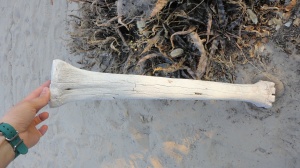
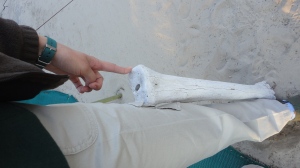
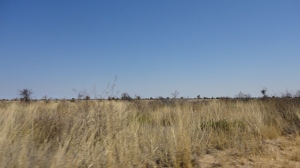
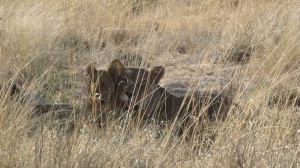
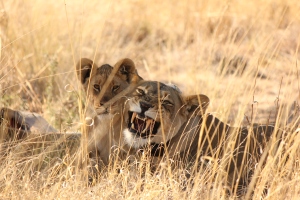
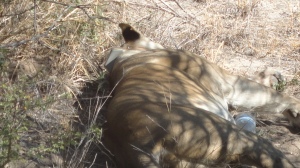
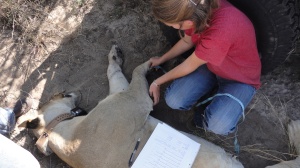
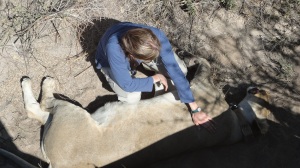
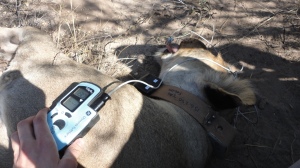
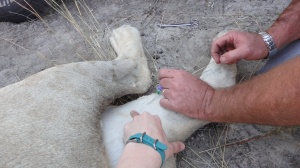
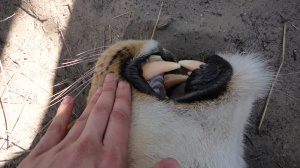
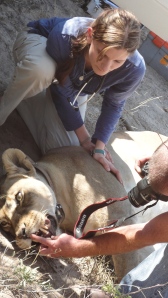
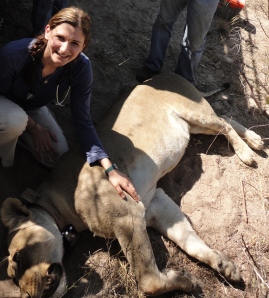
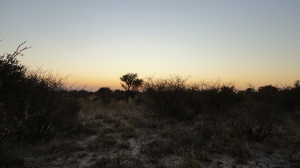
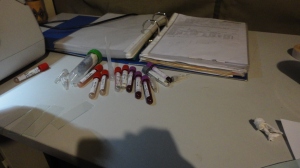
I knew that Mark was a good choice for a mentor because he is careful and a good teacher, but I am particularly impressed that he reviewed what to do in case of a human emergency. But I agree, I hope you don’t ever need it. I’m sorry you weren’t luckier tracking Mothamongwe!